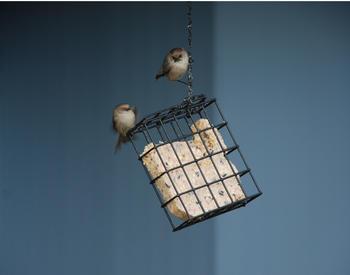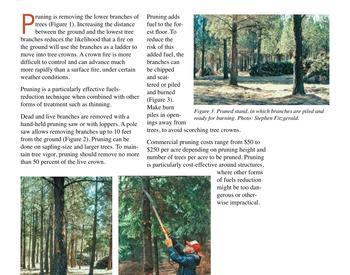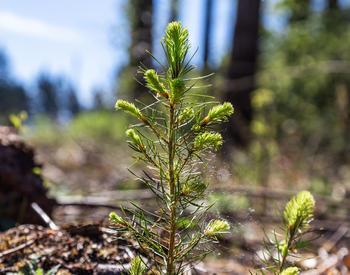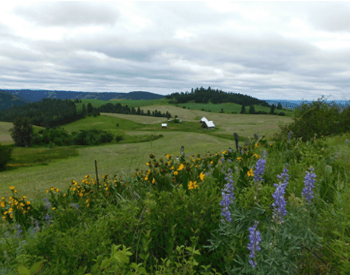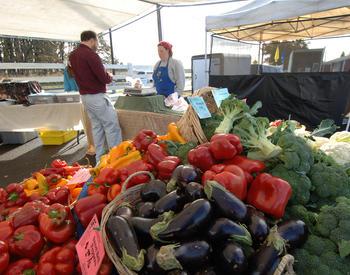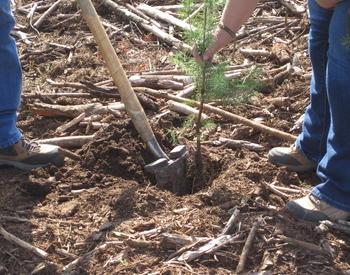Transcript
From the Oregon State University's Extension Service, you are listening to In The Woods with the Forestry and Natural Resources Program. This podcast aims to show the voices of researchers, land managers, and members of the public interested in telling the story of how woodlands provide more than just trees they provide interconnectedness that is essential to your daily life. Stick around to discover a new topic related to forests on each episode.
Jacob: Hello everyone and welcome back to In The Woods podcast presented by the Forestry and Natural Resources Extension Program at Oregon State University. I am your host, Jacob Putney, assistant professor of practice and extension agent in Oregon State University's College of Forestry. To build on the last episode, what's in a woodland, today's topic is how forests grow. Our guest today is John Bailey, professor of silviculture and fire management at Oregon State University. John, would you like to give a brief introduction of yourself and the work that you do?
John: Sure, and thanks Jacob for the introduction. It's quite an opportunity for me to be able to share you know some of this information with you today. Yeah first and foremost I'm a forester by training and a silviculturist, so I'm all about growing trees, but I also have a history of being a wildland firefighter and a prescribed burner and so the classesthat I teach are both the silvicultrure and the fire classes at Oregon State University in the College of Forestry. Then the research that my students and I do center around proactive fuels treatment, post-fire restoration kinds of projects, some work on actual active prescribed burning and these days a lot of larger scale fire behavior modeling risk analysis and a little bit of policy work.
Jacob: Thanks John that's great. I still remember some of the undergraduate forestry fire classes that I took back when I was a student.
John: Yeah back in the day.
Jacob: So with that I guess we'll kind of dive right into it. So how forests grow, so I guess we'll start kind of with the basics. What are the basic elements that trees need to grow?
John: Trees like the vast majority of plants they make their own food and so you know it's all about photosynthesis. The combination of sunlight and CO2 and water that is put together to manufacture carbohydrates that are then moved around and in order to grow new cells and for the plant to expand and function. Of course it needs enough warmth as well to make all the chemistry work for the plants to grow and that's what defines the growing season that combination of sunlight and warmth and having water available.
Jacob: Which of the resources are generally limiting?
John: That's why I've already mentioned water a couple times and in this part of the world, the water is for most of the year water is our most limiting factor. We have a predictable dry segment of that growing season when we have the sunlight and the warmth but water just is not available and that happens sometimes in other parts of the year as well. When water is available, you know early springtime right after snowmelt depending on what part of the state that you're in, then the most limiting factor or next on the list is probably nitrogen. Nitrogen is coming from the organic matter in the soil and that kind of thing of course you know it's a complex world out there and so other things can become limiting particularly in the colder part of the seasons or on you know some of the more non-fertile soil types there might be a an element like boron or manganese or something that could be limiting or that there could be too much of it. But by and large it's a game around water and organic matter nitrogen availability.
Jacob: I did my master's thesis on nitrogen fertilization, so I spent a lot of time trying to figure out why nitrogen varies so much across some of the coastal forest soils.
John: Exactly and the big fertilizer elements if you buy a bag down at the store is nitrogen, phosphorus, and potassium.
Jacob: So what kind of things affect resource availability?
John: So that's all going to be driven by climate and microclimate which is how aspect and elevation and you know small scale differences in topography. How the climate gets expressed on a general site of a piece of land. So that's you know that is the water input and to a certain extent the sunlight input as well as a kind of climatic picture. Then soils are crucial as well both in terms of that organic matter content because of nitrogen and other elements but also the soil depth and soil character that regulates the availability of those nutrients as well as water availability in and of itself. So you know this kind of all weaves together to come back to just what those basic things are that help plants trees grow. Then of course there's how many how many neighbors you know do you have that are competing for these resources.
Jacob: That's a good point and I think that brings us kind of to our next topic here. So in a forest, how does resource availability affect the growth of each of the trees?
John: So you know there are these basic interactions out there and there's some evidence that trees actually can cooperate with one another in terms of sharing resources. Root grafting and symbioses of different types and mycorrhizal relationships with fungus and those kinds of things. But by and large it's really kind of a competition game out there, in a normal forest setting. As a matter of fact you know we do a lot of work looking, trying to look at water use efficiency and your work on nitrogen use efficiency and those kinds of things but the larger and more competitive plants actually aren't even that worried about being efficient. There's plenty of evidence that they use the water that's available and the nutrients that are available because it's a competition game out there.
Jacob: So as a competition, are there some indicators of which trees might be the winners and which ones might ultimately be the losers?
John: Yeah and that's a game of speed and size and your ability to get out of the gates and get big fast and put leaf area out and start exploiting those site resources the water and the nutrients because that establishes early dominance and your ability to have a larger root system your ability to even cast shade on your neighbors and that will feed into all of the early growth that will maintain that dominance over time and ultimately get you to a reproductive age and so that you can be sustained you know long into the future of the forest.
Jacob: So let's say I just planted a stand of trees. Take us through a timeline of how this stand will develop over time or these stages of stand development.
John: Well and people that read up in the literature of this area, these stages of stand development are pretty predictable. We've been thinking about them and working on them for a long time you might see them referenced as stages of stand dynamics and I like the dynamic word because it is all it is a game of competition and change over time and responses to competition and responses to other disturbances that are happening out there and your ability to grow and exploit the resources, all the things that we've been talking about. There are four basic stages in stand dynamics and you know other authors, myself included, have embellished on that and inserted little sub-stages and cycles and all that kind of stuff but for today we'll stick to the kind of the four basic stages and they have good intuitive names.
The first is just stand initiation. When we initiate the stand following some kind of large-scale disturbance and that could be a harvesting you know activity a heavy harvest you know clear-cut or something close to a clear-cut, but it also includes floods, landslides, and of course my personal favorite which is the wildfire. Here these large-scale disturbances would be the more severe the higher intensity and more severe wildfires out there. So what happens during this stage of stand initiation all those resources that you know can otherwise limit growth you know there's not water availability you know before the disturbance there's not water available because of the large trees. The large trees might even you know tie up nutrients they're casting a lot of shade all those fundamental things that a small plant needs. Following a large-scale disturbance you know the gates are open for you know for anything that survives or anything that can sprout for any anything that can germinate from the seed you know they want to get established quickly, occupy the site, grow quickly, so this stage favors those fast growers and kind of weedy species. I use the analogy you might remember in some of the classes, you're kind of lining up at the buffet and this is when the buffet opens following some kind of large scale disturbances as many resources are going to be as available as ever, the competition is as intense as ever, the dynamics are super fast in terms of how things are changing and how the plants are interacting in order to exploit those resources, the water, the nutrients, the sunlight, the physical space, all of those kinds of things.
This is an interesting stage because you know because of all of those dynamics and all of those resources some wildlife species really favor these kind of early seral conditions to use the ecological term and they are closely tied to the availability of resources and those resources being close to the ground during this stage of stand development. The diversity is the highest because of that. There's the greatest range of conditions, and the greatest numbers of species of plants and bacteria and bugs and birds, this is a high diversity stage. This stage lasts you know as long as the resources that were created by the large-scale disturbance are still available as long as that growing space is there and new things can be coming in then we're still in the stand initiation phase.
But when that kind of growing space is no longer available you know then we enter what is known as the stem exclusion phase and that's another intuitive term. This is when individual stems start to exclude each other because the exploitation of the available resources only comes at the expense of your neighbor. So you're going to get bigger and use water and use nutrients and capture sunlight, since there's not new resources available those resources are only available if you, well to be blunt, you know kill your neighbor for this. But the buffet isn't an unlimited buffet anymore and so there's competition for everything that is out there and those resources the food on the buffet table is being claimed by the bigger and more aggressive individuals, they are the winners. That's why during that stand initiation phase being able to get out quickly and establish some dominance then carries into the stem exclusion phase which then can carry on into decades if not centuries into the future.
During the stem exclusion phase maintaining a really big crown that can capture the sunlight and maintain your dominance and you can keep your root system large as well and you can photosynthesize and grow should continue to shade out your neighbors as they die you can capture those resources that become available. In this way a stand of trees, a forest, self thins over time the larger dominant individuals keep getting bigger, the smaller individuals become over topped, suppressed, and ultimately die - fall to the forest floor and the nutrients start getting recycled and they're no longer using any of the sunlight or water or nutrient resources. This continues to happen and and fairly predictably, we have very well established models that look at this rate of self-thinning and how big the trees can get and the characteristics of the trees. They become taller and straighter as they're competing with each other relative to more open grown trees and through the process of self-thinning relatively small openings are created and the resources are captured by those dominant individuals and that continues to happen until the individuals that are dying because of self-thinning or other disturbance processes in the stand until a very large opening start being created and that's when we enter the third stage called understory reinitiation, another nice intuitive term.
So in this stage the openings that are created are large enough for regeneration to become established and survive long into the future and start developing stands into multiple stories so you have a second story and then if the opening is big enough or another opening happens next to it you can have a third story and then a fourth story as you head towards some future with a lot of vertical structure and horizontal diversity and mixes of species as more shade tolerant individuals can come into that stand and this third stage of understory reinitiation continues and you know if it goes long enough before another large-scale disturbance comes through then ultimately we end up in the fourth stage which is that classic old growth, mature forest, late seral kind of conditions where you basically have a full mix of tree sizes and species lots of standing down wood lots of large down logs on the floor and we're in a more self-sustaining system of small scale disturbances that maintain that mature structure over time. Or at least until another large scale disturbance comes through, and this is where the size and nature of those disturbances really guides which part of these stages that you're interested in and that your current stand is in.
So if you're growing wood as an industrial forest manager, or as a small private landowner that wants to grow trees quickly and maybe ultimately enter a market and sell some logs and those kinds of things, you're going to be really interested in that stand initiation phase and stem exclusion phase. You're going to want to get through stand initiation very quickly and then manipulate the tree characteristics through thinning and other practices during the stem exclusion phase until your crop, until the trees, are large enough that you can sell them and then you're going to do another large-scale disturbance, a harvest, and start it over again. Go quickly through stand initiation to get the species established that you want and the spacing that you want get it quickly into stem exclusion do the whole thing again or at least your children or your grandchildren will. If you're more interested in the structural kind of characteristics and the aesthetics and the habitat value of older, more mature forest types then you're not in that much of a hurry to go through the stand initiation phase following a big disturbance but you might want to shorten the stem exclusion phase because you want the trees, the individual trees to grow larger, faster and you like the openings and you want to start multiple stories and a range of species in there and so there you thin heavily in the stem exclusion phase and create gaps so that you can do the understory reinitiation and you foster that tree growth you know going through the future to develop the largest trees in the more mature forest structure as quickly as you can. So that's how we use these basic principles and our knowledge of these four stages of stand development in order to you know create the kinds of conditions that we want as landowners, that match our management objectives.
Jacob: I'm always surprised that even in some of the even age stands as how much heterogeneity there is and how just the interaction of these trees can create different stratifications both vertically and horizontally. So you talked a lot about disturbance and the role that it has in some of these stages, is there anything you'd like to add on disturbances in general?
John: Well you know we can manipulate those disturbances in terms of their frequency and their intensity that you know match our management objectives as best we can. You know fire is a great disturbance process. We can actively manage the stand or the landscape to try to keep fire out or we can use fire as a tool to manage long-term fire risk and those kinds of things going into the future. Same with thinning, if thinning is our human imposed selection of the winners and the losers.
Jacob: So I guess kind of as we're coming towards the end here, is there anything else you'd like to add on how forest grow?
John: Yes, you know I think we have to talk about climate change and wildfire and what that's you know currently representing for us now. Of course the warmer temperatures and higher co2 levels will increase the fundamental growth rate where we kind of started this podcast and that will speed up stand development in that sense trees will grow faster if there is sufficient water availability. Of course that's a big unknown and the other big unknown is if those disturbance processes and the scale of them, the mix of small-scale and large-scale disturbances - insects and wildfire - if those don't fundamentally change as we go forward. That's also a big unknown in this age of climate change and wildfire, you know how big will the fires be, what will be the patch size of these events and that'll be driven by the weather conditions during the fire season when these fires actually happen. But despite this you know this unknown, our land management professionals are being well prepared. OSU College of Forestry as you know is one of the best programs in the nation and you know we pride ourselves on the fact that we're training, have trained you, and you know we're training other you know generations of professionals that can take on these challenges. The forests are fundamentally you know more resistant and resilient to these various disturbances than we ever give them credit for. So I don't want to be too much of a doctor doom about climate change and in wildfire, there will be some things that happen that we haven't anticipated but the forest is resilient, we have good land management professionals, so I stay optimistic moving forward.
*Transition to Lightning Round*
Jacob: Well I wanted to thank you for joining us today John. As we start to kind of wrap up here, we have a few questions that we like to ask each of our guests. The first one being, what is your favorite tree?
John: That's a tough one since I'm a Virginia native, originally, even though I would often say I'd have to say that you know Douglas-fir is king. I think today I'll say that my favorite tree is yellow poplar, tulip poplar (Liriodendron tulipifera).
Jacob: That's good, yeah it's hard to not say Douglas-fir being from Oregon as well too. But I think the western larch is a close second for me so.
John: Yeah that's true.
Jacob: So what is the most interesting thing you bring with you in a field whether in your cruiser vest or other field kit?
John: It's hard to identify a single thing, but through my, I started my career carrying, you know coming out of Virginia, carrying just a pocket knife and a multi-function pocket knife. The years in Flagstaff, Arizona, Northern Arizona University, really taught me to carry chapstick as well. Then with the advances in technology my pocket typically now includes a third thing, a thumb drive.
Jacob: Yep, in the age of technology, right. So lastly here, what resources would you recommend to our listeners if they're interested in learning more about how forests grow?
John: Well you know we're blessed with the OFRI group, which I know co-sponsors this podcast series, so you know we we have one of the strongest extension programs and we have the OFRI group here in the state. Plus I'm a big fan, and a long-term member, of The Nature Conservancy and so they put out great information and have really good success stories that I often refer students to particularly when they're kind of overwhelmed with the challenges.
Jacob: Well that's great thank you, John.
Thanks so much for listening! Show notes with links mentioned on each episode are available on our website blogs.oregonstate.edu/inthewoodspodcast. We'd love to hear from you! Visit the tell us what you think tab on our website to leave us a comment, suggest a guest or topic, or ask a question that can be featured in a future episode. And also give us your feedback by filling out our survey. In The Woods is produced by Lauren Grand, Carrie Berger, Jacob Putney, Stephen Fitzgerald, and Jason O'Brien, who are all members of the Oregon State University Forestry and Natural Resources Extension team. This podcast is made possible by funding from the Oregon Forest Resources Institute. Music for In The Woods podcast was composed by Jeffrey Hino, and graphic design was created by Christina Friehauf. We hope you enjoyed the episode and we can't wait to talk to you again next month. Until then, what's in your woods?
In this episode of In The Woods, Jacob Putney is joined by John Bailey to learn about the foundations of forest growth.
